13 Types of BROWN And BLACK BIRDS (ID Guide With Photos)
Did you recently come across a brown and black bird, and want to know what species it was?
Identifying birds that have brown as well as black feathers is not as easy as it might seem, since there are surprisingly many birds in North America that fit this description.
To help you identify the bird you saw, we’ll cover all the brown and black birds of North America.
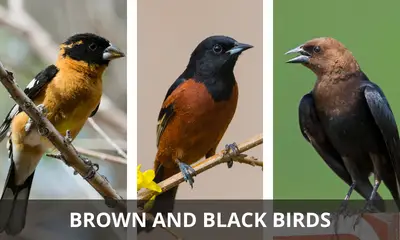
What types of birds are brown and black?
There are 13 types of birds that are black and brown in North America, which are covered in full detail below.
Brown-headed Cowbird
Scientific name: Molothrus ater
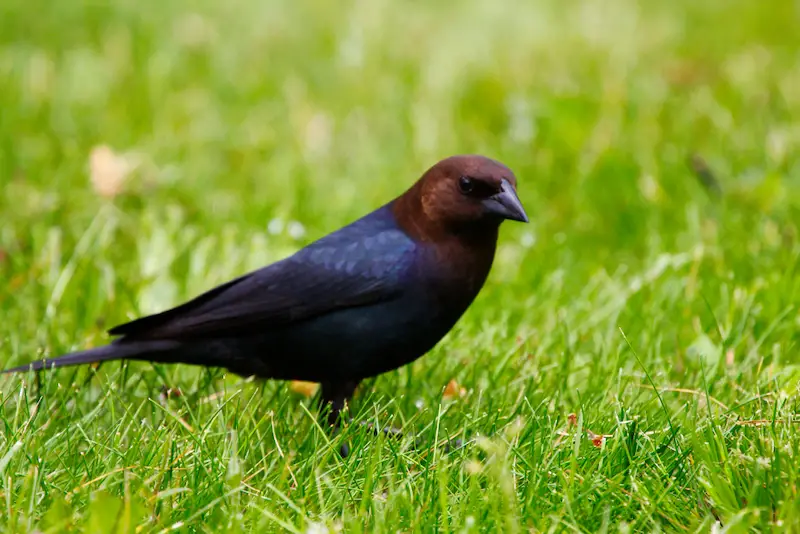
Adult male Brown-headed Cowbirds have a chocolate-brown head and an iridescent black body. Females, on the other hand, are dark gray-brown.
Cowbirds are a type of blackbird, but differ from other blackbird species in one key characteristic: they are brood parasites.
A brood parasite is a type of bird that doesn’t build nests, but instead lays its eggs in the nests of other birds.
Brown-headed Cowbirds have been reported to lay their eggs in the nests of hundreds of other bird species.
If you see a warbler or other small bird feeding a young bird twice its size, you can be fairly certain that it’s raising a Cowbird.
Black-headed Grosbeak
Scientific name: Pheucticus melanocephalus
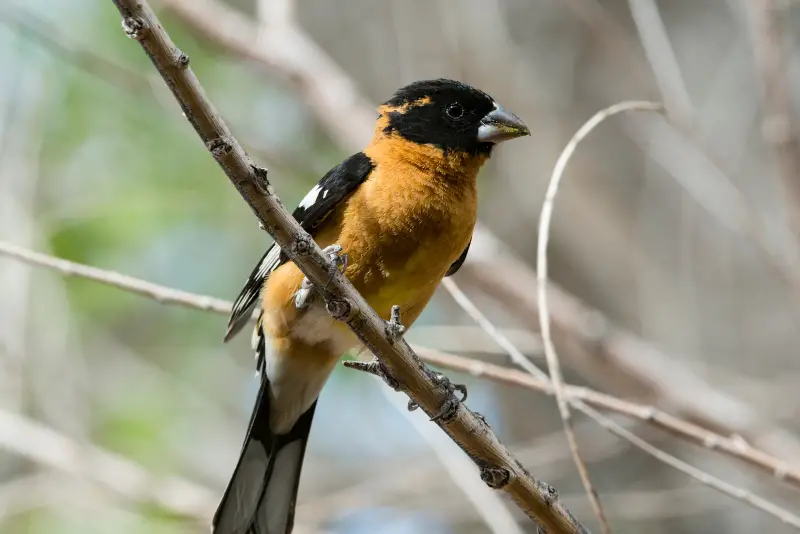
This large billed songbird is a breeding bird of the western United States, where it is a summer visitor from May to August.
Males can be recognized by their black wings, head and back, which contrast with a deep orange-brown underside, collar, and rump.
In some individuals, the underside is more orange, while in others, it is more chestnut brown, while the upperparts are always black.
Females, on the other hand, are buff brown with white streaks. They can be readily distinguished by their white supercilium (eyebrow stripe) and white throat.
Orchard Oriole
Scientific name: Icterus spurius

This oriole got its name from its preference for orchards and open woods.
Males are characterized by a dark rusty brown underside, which contrasts with their ebony black head, back, wings, and tail. Females have mostly dull yellow plumage with black wing tips.
Young males resemble females in color, and gradually become darker and more black over their first two years.
Early in the summer, these black and brown orioles feed on insects, but later switch to eating wild fruit as they become mature.
After their young have fledged, parent Orioles will bring them to feeding stations (especially to nectar feeders).
Orchard Orioles are summer visitors that arrive in their breeding range very late in the spring and are among the first birds that leave again early in the fall.
Eastern Towhee
Scientific name: Pipilo erythrophthalmus
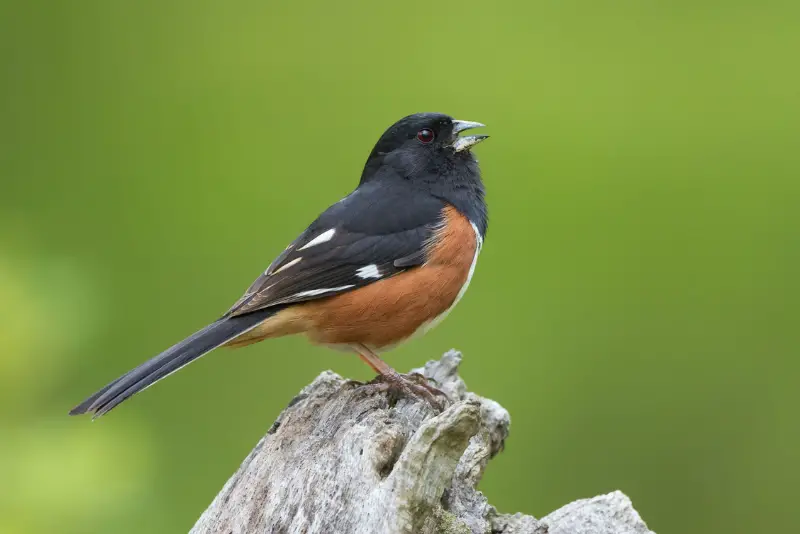
Towhees got their name from the characteristic “Tow-hee” cry that both genders use.
Male Eastern Towhees are black combined with rusty-brown sides and a white belly.
When the Eastern Towhee takes to the air, white comma-shaped wing patches become visible on the upper side of its black wings.
Although the female incubates the eggs until they hatch, the male does the heavy lifting when it comes to feeding the young.
The Eastern Towhee, similar to all other species of towhee, forages by making a comical backwards hopping motion with both feet at the same time.
It does this in order to displace leaves and expose the seeds and insects that are concealed under them.
You can readily attract these little black colored birds to your feeder with black oil sunflower seeds.
Spotted Towhee
Scientific name: Pipilo maculatus
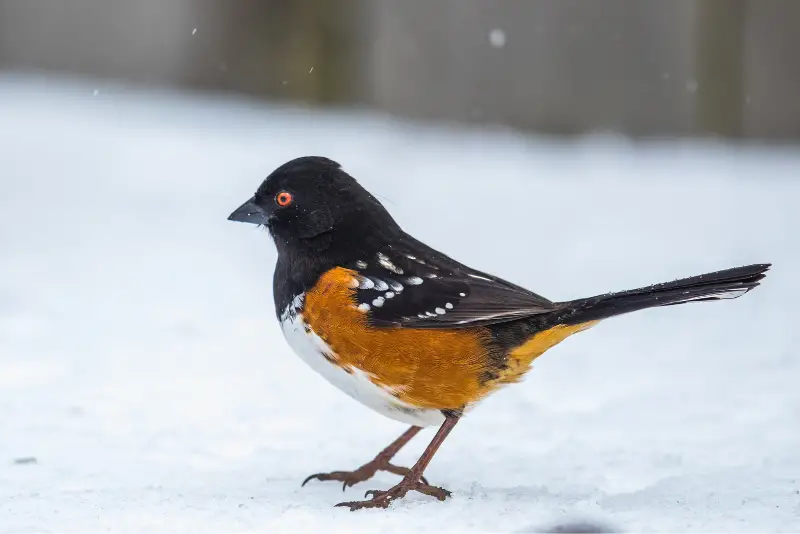
The Spotted Towhee is a songbird of the western USA, where it is a migratory bird in the northern part of its range, and a year-round resident in the southern part.
Male and female Spotted Towhees look similar and have a black hood and black upperparts marked with white dots, while their flanks are rusty brown.
The migratory part of the population has a winter range that extends southwards towards Mexico.
Harris’s Sparrow
Scientific name: Zonotrichia querula
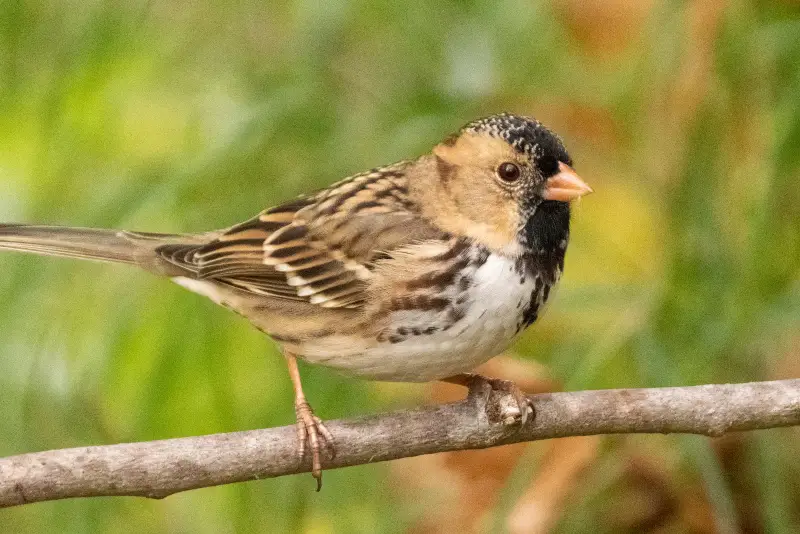
The Harris’s Sparrow breeds in the boreal forests of Northern Canada, but winters in the Great Plains of the United States.
Adults have a distinctive black face that contrasts with their mottled brown back and pink bill. The white belly also has black streaking on the flanks.
As granivores, Harris’s Sparrows eat seeds and can become regular guests at bird feeders in their wintering range.
Cactus Wren
Scientific name: Campylorhynchus brunneicapillus
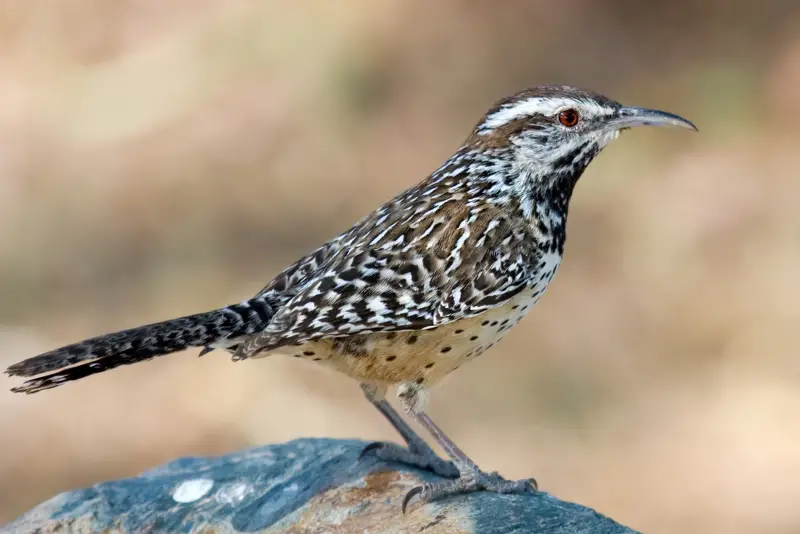
If you notice a desert bird resembling a cross between a thrasher and a wren perched on a cactus, you’re probably looking at a Cactus Wren.
Both sexes of this bird look alike, and are predominantly grayish brown with dark brown and black streaks thrown in for good measure.
The best distinguishing features of the Cactus Wren are its brown crest, the long and slightly downturned bill, as well as the bright white eyebrow stripe.
You can also identify it by its harsh, chattering call, which sounds like someone trying to start a car. If you get close enough to one of these brown birds, you’ll notice that their eyes are dark ruby red.
The Cactus Wren is a year-round resident of the southwestern United States, and is commonly found in desert landscapes.
As you might have guessed from its name, it’s often found near cacti and uses them as a lookout when searching for insects and other small invertebrates on the ground.
Brown-capped Rosy-Finch
Scientific name: Leucosticte australis
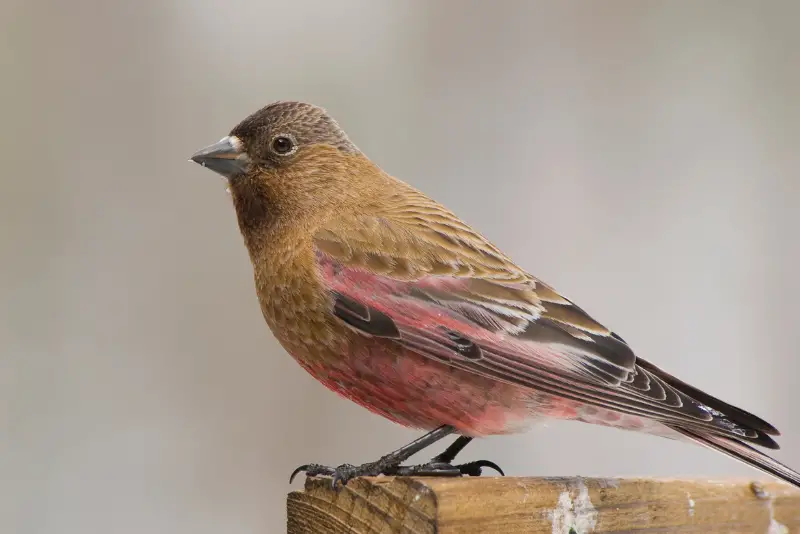
The Brown-capped Rosy-Finch is a tough bird found in high-altitude mountainous environments of the western United States.
Male birds have a black crown and black wings, as well as a cinnamon-brown back and head, which contrast with reddish pink hues on their wings, back, and belly.
Female and juvenile birds have more uniform grayish brown feathers with very little pink.
The Brown-capped Rosy-Finch is an alpine specialist, and is mostly found in the eastern Rocky Mountains.
During the cold season this brown bird forms small flocks that perform altitude migrations to lower heights in response to heavy snowfall in the Rockies.
Northern Bobwhite
Scientific name: Colinus virginianus

This small quail species is native to the eastern United States, where its numbers are unfortunately on the decline.
Males have a striking combination of black and white feathers on their head, which contrast with their cinnamon underside and dappled brown upperside.
They usually forage in pairs or small groups. During the breeding season, males sometimes perch at the top of bushes and scrubs when singing their territorial song.
California Quail
Scientific name: Callipepla californica
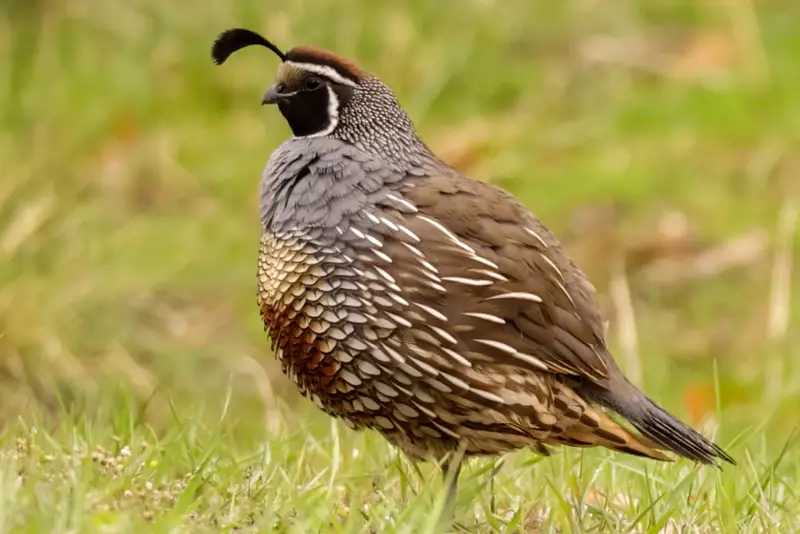
The California Quail is the state bird of California and is also known as the Valley Quail.
The body plumage of California Quails is a mix of dark gray and brown, contrasting with their jet black face and black crest. The body is also covered white spots and streaks.
Despite having wings and the ability to fly, California Quails are predominantly ground dwellers, and are in fact excellent runners that can reach speeds of twelve miles per hour.
They are very social birds and like to stay in groups. One advantage of this is that they will have many eyes looking out for predators which in turn keeps them safer.
California Quails are omnivorous and for the most part enjoy feeding on seeds, acorns, berries, leaves, flowers, bulbs, and insects.
Killdeer
Scientific name: Charadrius vociferus

While Killdeer are technically shorebirds, they are often encountered in man made habitats far from water, including golf courses, playing fields, and parks.
Their plumage seems almost colorful compared with other plovers, with warm notes of rusty brown contrasting with black, and some areas of white mixed in with each other.
Killdeer are widespread and common breeding birds in many parts of North America, and can be seen anywhere there are wide open lawns.
Ruddy Turnstone
Scientific name: Arenaria interpres
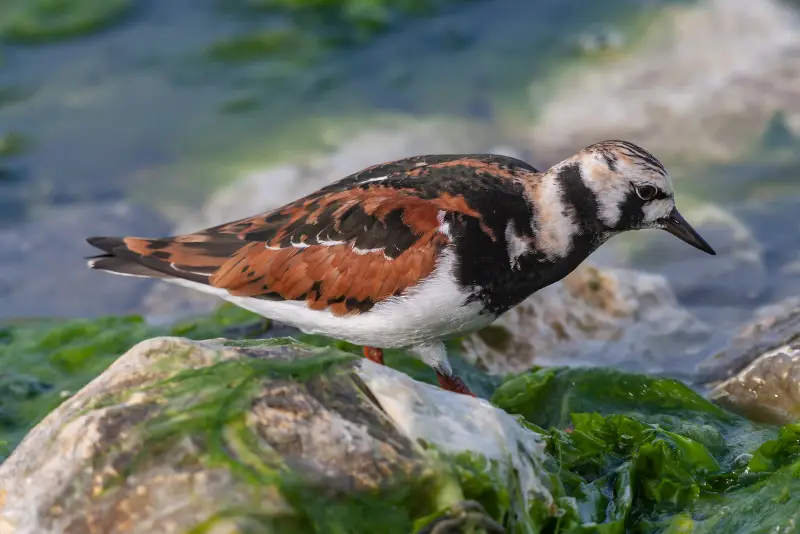
During the breeding season, Ruddy Turnstones have a strikingly colored plumage consisting of a black and white pattern on their head and chest, which contrasts with their rusty brown back and wings.
It breeds in the Arctic Tundra in Alaska and Canada, and even all the way up to Greenland, but is a regular winter visitor along all the coastlines of the United States.
This beach bird prefers rocky shorelines (where it lives up to its name and turns over rocks to find invertebrates), but it can also be encountered on sandy beaches, and along estuaries and mudflats.
Final remarks
In summary, here are the 13 types of birds in North America that have black and brown feathers:
- Brown-headed Blackbird
- Orchard Oriole
- Black-headed Grosbeak
- Eastern Towhee
- Spotted Towhee
- Harris’s Sparrow
- Cactus Wren
- Brown-capped Rosy-finch
- Northern Bobwhite
- California Quail
- Killdeer
- Ruddy Turnstone
If you’ve spotted one of these brown birds while bird watching in your backyard, hopefully this ID guide will help you identify it quickly and easily.
And if you enjoyed this article, check out our guide to the types of brown and red birds.
